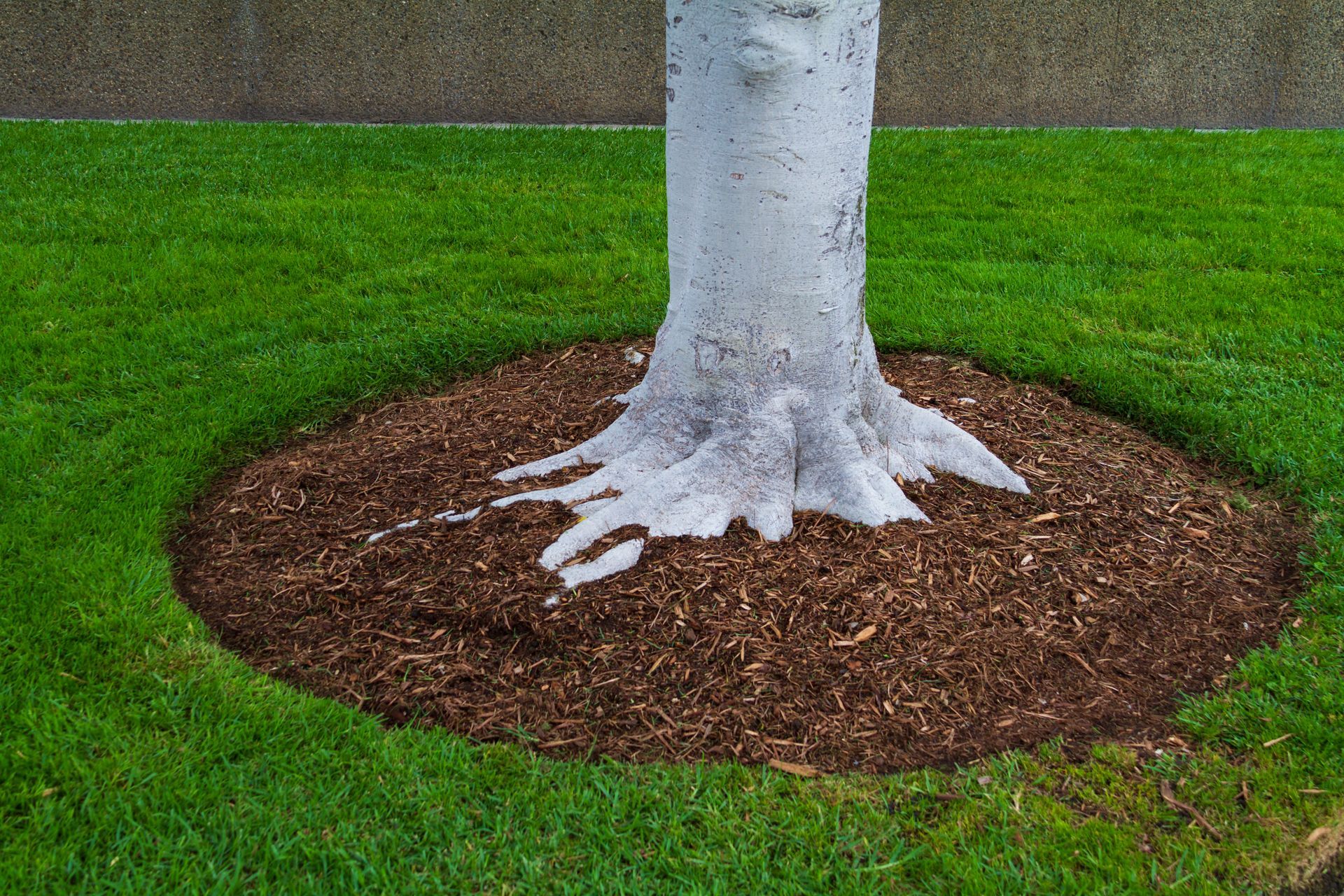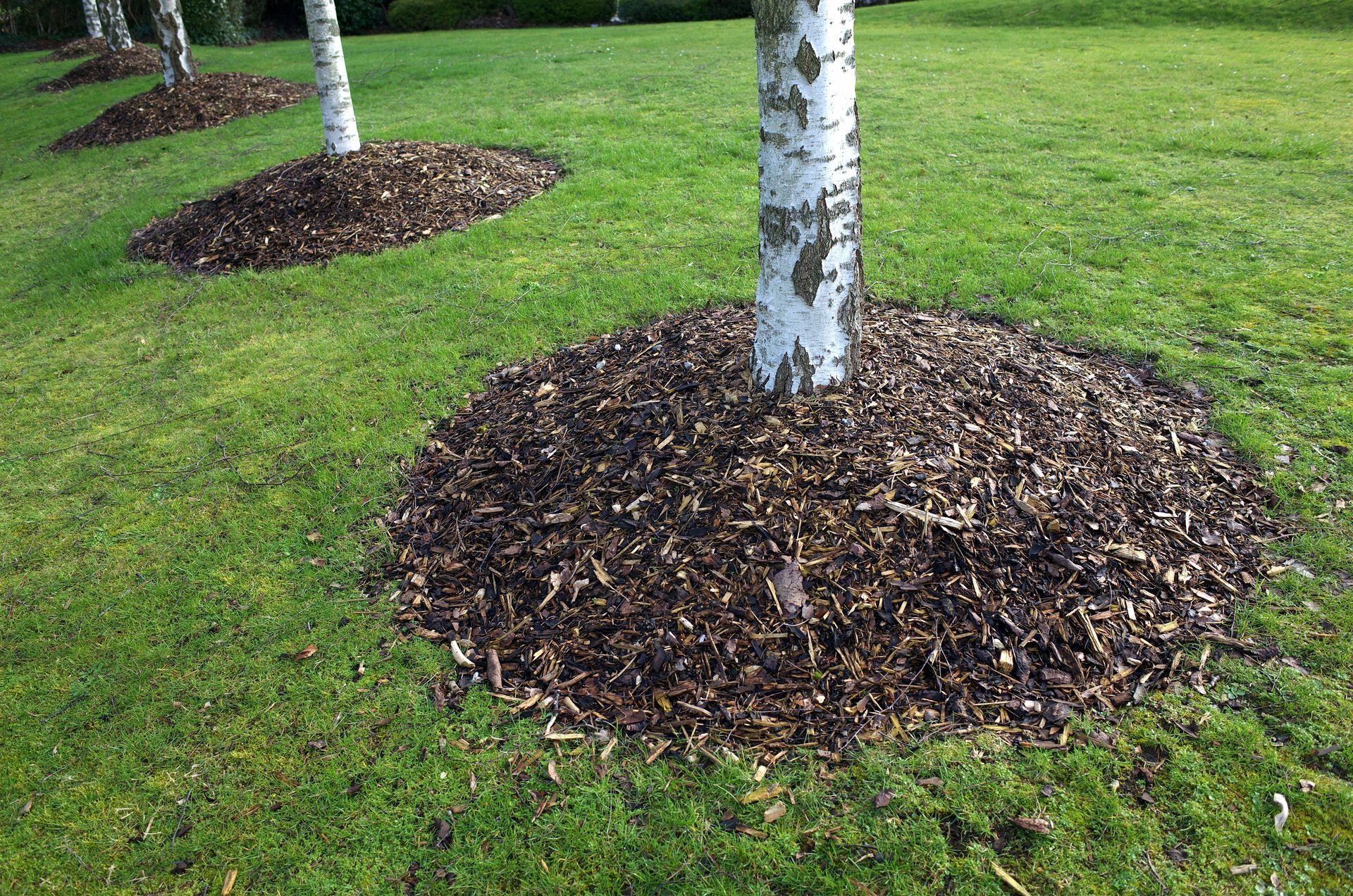Mulching Around Trees

Mulching around trees is a task most people mess up - even experienced landscapers. There is a right way to do it and a wrong way to do it but please for the love of God, avoid volcano mulching your trees. We'll explain below.
Table of Contents
How to Mulch Around Trees: Dos and Don'ts
First, we'll talk about the proper way to mulch a tree, and then we'll get into the things to avoid. The best time to do this is in the Spring, but honestly, you can do it anytime of the year. But why would anyone do it in the Winter? Spring is nice because temperatures start to get warmer, and the tree's root system begins to grow.
Did You Know? Research suggests that a properly mulched tree can double the growth rate of the tree. However, incorrectly mulching will kill the tree fast.
Proper Way to Mulch Around Trees
First things first, stick with organic mulch. Get yourself some Hardwood bark. It's cheap mulch made of bark, leaves, and wood, but it does the job. Organic mulches are going to enhance the soil quality around your tree, which is a bonus.
Now, let's get to laying the mulch. Mulch as much as possible but make sure you get out to the "drip line." What's the drip line?
The drip line is just the outermost edge of the tree's canopy, where water would "drip" when it rains. Just remember that if your tree grows, the drip line gets pushed out. You can either adust as the tree grows, or you can add more the next season.
2 - 4 inches of mulch will do. If the soil drains well, you can use less but you definitely don't want to use more. If you are using finely ground mulch, then go down to 1 - 2 inches because the roots can't breathe as well in this kind of mulch. We'll explain more below.
Most important step other than keeping the mulch layer short: keep the mulch away from the tree trunk. You want the tree root flare to show so be careful not to bury the tree in mulch. The root flare is part of the trunk where you can begin to see the root system start growing into the earth. Some tree's have more prominent root systems than others.
Benefits of Mulching Around Trees
There are a lot of benefits of mulching trees. A properly mulched tree:
- Stops weeds from growing that compete with the tree roots for nutrients and water
- Conserves soil moisture
- Protects roots from extreme temperatures in either the summer of the winter
- Allows the roots to "breathe" by preventing soil compaction
- Mulching makes even the best front yard trees look even better
Incorrect Way of Mulching Around Trees
Now, the number one thing to avoid with trees is overmulching or mulching volcanoes. This is basically when mulch climbs up the tree trunk and smothers the root zone. It's obvious when you see it. A picture is worth a thousand words:

Why Overmulching Around Trees is Bad
There are a number of different reasons why you want to avoid overmulching or volcano mulching but here are the main few:
- Bark Death
- Disease & Insects
- Rodent Damage
- Tree's Root System Can't Breathe
- Too Hot
Bark Death
The tree's inner bark starts to die. When you cover the bark with mulch, you keep the bark wet. Unlike roots, the tissue within the inner bark of the tree's trunk and root flare cannot survive when it's constantly wet. When it dies, it can no longer carry nutrients from the tree leaves to the rest of the tree.
Disease & Insects
Fungal and bacterial diseases thrive in moisture caused by over-mulching. Over-mulching keeps the trunk constantly wet, which kills the bark, and if there are wounds under the bark, bacteria, and disease can easily get into the tree. Some of these diseases are fungal tree cankers, root rot, and more. Not only that but insects like carpenter tree ants or termites can also get into the tree. They will colonize and wreak havoc on the tree if they are not maintained.
Rodents
Rodents are another issue that come with overmulching. Mice will burrow underneath the deep layers of mulch for shelter, and also for food. They will feast on the nutritious part of the inner stem which will eventually kill the tree. You might also need a tree shelter for young trees when it comes to stopping rodents.
Lack of Oxygen
If you cover the area above the tree root system with too much mulch, you are going to starve the tree of air. The air can't penetrate through thick mountains of mulch. If soil oxygen levels drop too low, the root system begins to decline, and the tree can eventually die. Also, just like near the bark, too much water can build up and fail to evaporate. The tree basically "drowns" because too much water prevents oxygen from getting down into the soil.
Heat
When the mulch starts to decompose, it will begin to heat up. Mulch piles can get well over 130 degrees, and this type of heat can kill the inner bark of the tree. It's just like composting.
How to Fix Overmulched Trees
If you think you have an over-mulched tree, don't worry, it is relatively easy to fix. It's less obvious to spot. Just look for the root flare and the volcano and you should be able to tell if there is too much mulch.
Rake away excessive mulch down to that 2 to 4-inch limit. If the soil doesn't drain well, you can go down to 1 to 2 inches. For young trees, you want to pull that mulch away from the flare about 4 to 5 inches. But with mature trees, you want to pull it away around 9 to 10 inches.
Again, push the mulch out to the drip line, or just passed the canopy of the tree. And be sure the depth does NOT go any deeper than 4 inches.
Sweet New Earth's Final Word on Mulching Around Trees
Mulching around trees is pretty easy. Avoid the common mistakes, and you are good to go. If you don't feel comfortable doing it, you can always contact an arborist, who can help you.
Remember, mulching is great for things like conserving soil moisture but excess mulch or mulch volcanoes will kill your tree. You put too much and jeopardize root growth. You don't put any, and you fear lawn mowers.
That's it for this article! If you enjoyed it, be sure to check out some of the other guides on trees, tree care and tools for pruning trees.
FAQs

Carl Anderson
Carl Anderson is an avid outdoorsman with a keen interest in writing about and reviewing tools. He has over 20 years of writing experience and the only time he isn't feverishly typing away at his computer is when he's outside in nature working on his projects. You can learn more about him here.
Join our community!
Join to receive guides, insights, and the latest gardening deals!
